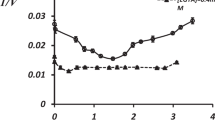Abstract
The subcellular distribution of kainic acid (KA) binding sites in rat brain has been studied using a microcentrifugation assay. KA did not bind to myelin or brain cytosol and had few or no binding sites in the nuclear fraction. However, it bound to microsomal components (K d =128–136 nM; 2.5–4.8 pmol/mg protein), purified synaptic plasma membranes (SPM) (K d =45–71 nM; 5.8–6.5 pmol/mg), and purified cell-body and intraterminal mitochondria (K d =11–31 nM; 0.4–1.1 pmol/mg). Bound KA could be totally displaced byl-glutamate orl-aspartate, but several putative antagonists of these amino acids (nuciferin, compound HA-966, 2-amino-4-phosphonobutyrate, and 2-amino-3-phosphonoproprionate) failed to displace KA or did so at very high concentrations (≥4 mM). Glutamic acid diethyl ester (GDEE) andd,l-α-aminoadipate (α-AA) were more effective (IC50, 0.2–0.8 mM) and showed differential effects in their capacity to displace KA bound to the various subcellular fractions. Thus, GDEE only displaced 40–60% of the KA bound by SPM or mitochondria and did not prevent the binding of KA to microsomes. α-AA, on the other hand, was more effective in preventing the binding of KA at high concentrations and displaced between 80 and 100% of the drug. Both compounds showed biphasic curves of KA displacement from synaptic plasma membranes and mitochondria. The overall results indicate the presence of multiple binding sites for KA in brain cells and suggest that KA does not act exclusively at synaptic glutamate receptors. The mechanism of KA action is most likely quite complex, and the drug probably acts at multiple binding sites affecting a number of processes.
Similar content being viewed by others
References
McGeer, E. G., Olney, J. W., andMcGeer, P. L. (eds.) 1978. Kainic Acid as A Tool in Neurobiology. Raven Press, New York.
Olney, J. W. 1976. Brain damage and oral intake of certain amino acids. Adv. Exp. Med. Biol. 69:497–506.
Campochiaro, P., andCoyle, J. T. 1978. Ontogenetic development of kainate neurotoxicity: Correlates with glutamatergic innervation. Proc. Natl. Acad. Sci. U.S.A. 75:2025–2029.
Schwarcz, R., Scholz, D., andCoyle, J. T. 1978. Structure-activity relations for the neurotoxicity of kainic acid derivatives and glutamate analogs. Neuropharmacology 17:145–151.
Hall, J. G., Hicks, T. P., andMacLennan, H. 1978. Kainic acid and the glutamate receptor. Neurosci. Lett. 8:171–175.
Nadler, J. V., Perry, B. W., andCotman, C. W. 1978. Intraventricular kainic acid, preferentially destroys hippocampal pyramidal cells. Nature 271:676–677.
Simon, J. R., Contrera, J. F., andKuhar, M. J. 1976. Binding of [3H]kainic acid, an analogue ofl-glutamate, to brain membranes. J. Neurochem. 26:141–147.
Nieto, M., Shelton, D., andCotman, C. W. 1979. Multiple kainic acid binding sites in rat brain. Trans. Am. Soc. Neurochem. 10(1):191.
Cotman, C. W., andTaylor, D. 1972.Isolation and structural studies on synaptic complexes from rat brain. J. Cell Biol. 55:696–711.
Cotman, C. W. 1974. Isolation of synaptosomal and synaptic plasma membrane fractions. Methods Enzymol 31:445–452.
Jones, D. H., andMatus, A. I. 1974. Isolation of synaptic plasma membrane from brain by combined flotation-sedimentation density gradient centrifugation. Biochim. Biophys. Acta 356:276–287.
Clark, J. B., andNicklas, W. J. 1970. The metabolism of rat brain mitochondria. Preparation and characterization. J. Biol. Chem. 245:4724–4731.
Lai, J. C. K., andClark J. B. 1976. Preparation and properties of mitochondria derived from synaptosomes. Biochem. J. 154:423–432.
Johnson, D., andLardy, H. 1967. Isolation of liver or kidney mitochondria. Methods Enzymol. 10:94–96.
Tyler, D. D., andGonze, J. 1967. The preparation of heart mitochondria from laboratory animals. Methods Enzymol. 10:75–77.
Lowry, O. H., Rosebrough, N. J., Farr, A. L., andRandall, R. J. 1951. Protein measurement with the Folin phenol reagent. J. Biol. Chem. 193:265–275.
Johnston, G. A. R., Kennedy, S. M. E., andTwitchin, B. 1979. Action of the neurotoxin kainic acid on high affinity uptake ofl-glutamic acid in rat brain slices. J. Neurochem. 32:121–127.
London, E. D., andCoyle, J. T. 1979. Specific binding of [3H]kainic acid to receptor sites in rat brain. Mol. Pharmacol. 15:492–505.
White, W. F., Nadler, J. W., andCotman, C. W. 1979. The effect of acidic amino acid antagonists on synaptic transmission in the hippocampal formation in vitro. Brain Res. 164:177–194.
Davies, J., andPolc, P. 1979. Effects ofl-nuciferin or kainate,N-methyl-d-aspartate and acetylcholine excitation of cat spinal neurons. J. Pharm. Pharmacol. 31:178–179.
Idoyaga-Vargas, V., Santiago, J. C., Petiet, P. D., andSellinger, O. Z. 1972. The early post-natal development of the neuronal lysosome. J. Neurochem. 19:2533–2544.
Cotman, C. W., andMatthews, D. A. 1971. Synaptic plasma membranes from rat brain synaptosomes: Isolation and partial characterization. Biochim. Biophys. Acta 249:380–390.
Gurd, J. W., Jones, L. R., Mahler, H. R., andMoore, W. J. 1974. Isolation and partial characterization of rat brain synaptic plasma membranes. J. Neurochem. 22:281–290.
Cotman, C. W., andHamberger, A. 1978. Glutamate as a neurotransmitter: Properties of release, inactivation and biosynthesis. Pp. 379–412,in Fonnum, F. (ed.), Amino Acids as Chemical Transmitters, Plenum Press, New York.
Fricke, U. 1975. Tritosol, a new scintillation cocktail based on Triton X-100. Anal. Biochem. 63:555–558.
Author information
Authors and Affiliations
Rights and permissions
About this article
Cite this article
Nieto-Sampedro, M., Shelton, D. & Cotman, C.W. Specific binding of kainic acid to purified subcellular fractions from rat brain. Neurochem Res 5, 591–604 (1980). https://doi.org/10.1007/BF00964781
Accepted:
Issue Date:
DOI: https://doi.org/10.1007/BF00964781




